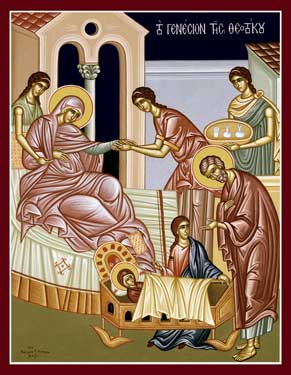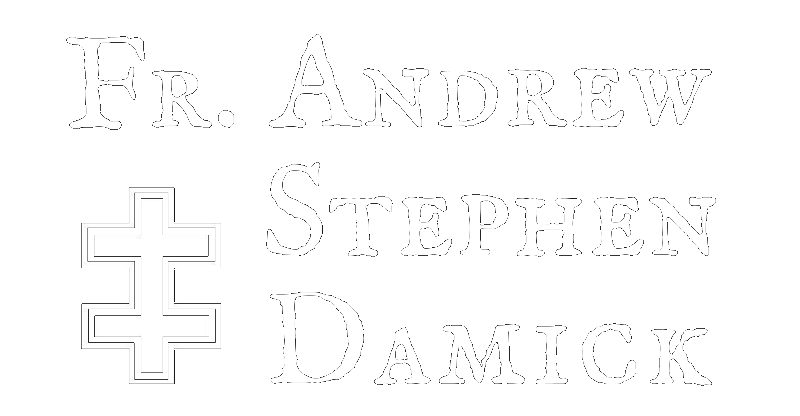
The Nativity of the Theotokos, September 8
In the Name of the Father and of the Son and of the Holy Spirit, one God. Amen.
In the Book of Exodus, after the Hebrew people left the land of Egypt, they wandered in the desert for some forty years before they finally came to the Promised Land. During this time, they met with God on the holy mountain of Sinai. There, they worshiped God by offering up sacrifices to Him. One of these sacrifices is described in the 24th chapter of Exodus, and then the next passage is dedicated to a meeting that took place between God and the Prophet Moses.
Moses ascends up the mountain to meet with God, and there God gives Moses some very detailed instructions regarding worship. Everything is there for how to construct the mobile worship space for the Hebrews, called the Tabernacle, including details on dimensions, building materials, tapestries, specific designs for iconography, what the priests should wear, and so on. Anyone who takes the time to read chapters 25 through 29 of Exodus could never come away with the impression that God does not care about the details of how we worship Him.
The first chapter with these instructions is dedicated to an object which is at the very center of the Tabernacle, the Ark of the Covenant. The Ark was a large wooden chest covered with gold and adorned with images of angels. On it was a golden throne called the Mercy Seat. Eventually the Ark was used to contain several holy objects, including the tablets of the Ten Commandments, a bowl of the manna God sent down from heaven to feed the Hebrews, and the miraculously budding staff of Aaron, the brother of Moses.
The Ark was a throne where God communed with His people. It was so holy that to touch it unworthily was to die. It was at the very center of Hebrew worship of the One True God, and it was sometimes even carried into battle with them to bring the power of God to bear in the face of Israel’s enemies. The Old Testament Scriptures mention the Ark a number of times, and several rare scriptural expressions are used when referring to the Ark.
When we come to the New Testament, we see a repeat of some of these rare expressions of language, but this time, this language refers not to the Ark, not to the Temple in Jerusalem, nor to any other object. Rather, this language is used when referring to Mary, the Mother of Jesus Christ, the One True God. When the Gospel writers wanted to refer to the Virgin, they realized by the power of the inspiration of the Holy Spirit that all the symbolism and real power that surrounded the Ark of the Old Covenant now had been transferred to the Ark of the New Covenant, the Virgin Mary herself, the Theotokos.
This is why when we come to the feasts of the Mother of God, such as we celebrate today, we often hear in the hymns quotations from the Old Testament referring to the Ark of the Covenant. In the Virgin Mary, we approach the new Ark of the New Covenant, no longer a lifeless golden box but a living, breathing human being who mystically and physically contained within herself the Everlasting God of the Universe.
In the Old Testament, to approach the Ark of the Covenant was to approach the Lord God Himself. This was not because God could be contained within a golden box, but rather because God chose that golden box as a place of utmost holiness and divine presence on Earth. There on that Mercy Seat God communed with His people in a powerful, mystical way. And now the Lord has approached us once again, but the locus of His coming to Earth is a human woman.
And just as the Ark of the Old Covenant was carefully constructed and prepared by human hands, so, too, was the new Ark carefully prepared. But instead of the preparation of carpenters and goldsmiths, the preparation of the Virgin Mary was by her quiet and humble obedience to and cooperation with the will of God.
This is why we honor the Virgin Mary, not because we want to elevate her to the status of a goddess and worship her, but because she is the carefully prepared vessel which bore the God of the Universe, the Second Person of the Holy Trinity, the Son of God, Jesus Christ. Through her came our salvation. Through her came a new life for every human being and the whole world. Through her came union between God and man.
Therefore, we approach her today and venerate her on her birthday because we desire to approach and come close to the Son of God. We respect her and sing about her glory because that glory is the glory of the awesome God. We call upon her here at the center of our worship just as the Hebrews placed the old Ark at the center of theirs, not because she or a golden box are to be the object of worship, but because the Ark is the place of worship, because the Ark of the Old Covenant and now the Ark of the New Covenant are the place where God has chosen to draw near to His people.
As we look upon the icon of the Holy Virgin, we see that she points us to her Son. Today, as we celebrate her birth into this world, may we hear her call to draw near to her holy Son. As we gaze upon the glory that surrounds her as more honorable than the cherubim and more glorious beyond compare than the seraphim, may we be drawn into a true encounter with that glory, the glory which is God’s and may also be ours if we are in union and communion with Him, just as she is.
To the Holy Trinity therefore be all glory, honor and worship, to the Father and to the Son and to the Holy Spirit, now and ever, and unto ages of ages. Amen.




Father bless,
Wonderful homily. Can you point to an article or examples where I can read more about the expressions you refer to:
” The Old Testament Scriptures mention the Ark a number of times, and several rare scriptural expressions are used when referring to the Ark. When we come to the New Testament, we see a repeat of some of these rare expressions of language, but this time, this language refers not to the Ark, not to the Temple in Jerusalem, nor to any other object. Rather, this language is used when referring to Mary, the Mother of Jesus Christ, the One True God. When the Gospel writers wanted to refer to the Virgin, they realized by the power of the inspiration of the Holy Spirit that all the symbolism and real power that surrounded the Ark of the Old Covenant now had been transferred to the Ark of the New Covenant, the Virgin Mary herself, the Theotokos.”
Thank you.
Father,
Thank you for this post, it puts the Theotokos into context in the larger plan of Christ’s Birth, etc. in a very simple to understand way.
– Richard
Hello Andrew,
First, I have had the chance to listen to some of your podcasts on AFR and have found them to be both insightful and enjoyable. Second, when I initially read this post, I was going to ask the same question as Greg already has (but I initially didn’t so in order to avoid redundancy). But, if by bringing it up again I may motivate a response, concrete examples of the NT language to which you refer would indeed be nice to see and consider. Thank you for the post.
God bless you,
Phil
Forgive me; I’ve been traveling a lot lately and haven’t had time to go hunting down the notes that this homily originally drew on. In any event, there’s some of what I’m referring to in this section from the OrthodoxWiki.
Thank you so much for taking time to respond, and I look forward to viewing the OrthodoxWiki site. I hope I didn’t come across as rude, as I know you must be quite busy! Thanks again.
The Ethiopian Tewahedo Church claims to have the original Ark. Anything to that?
I’ve never been to Axum to see (mind you, they wouldn’t let me see even if I went). But there’s a pretty strong tradition that they do, indeed, have it.
God bless you, Father Andrew,
Thanks for delivering this wonderful homily. I pray this will help bridge the gap between us and the Protestant world.
I look forward to meeting you again in person. May God be with you in your travels,
Roger Hunt
(formerly of St. Michael’s in Van Nuys, now of Holy Cross in Ormond Beach, FL)
Thank you, keep it up! May God bless you always.
Many thanks for this wonderful homily, Father! God bless.